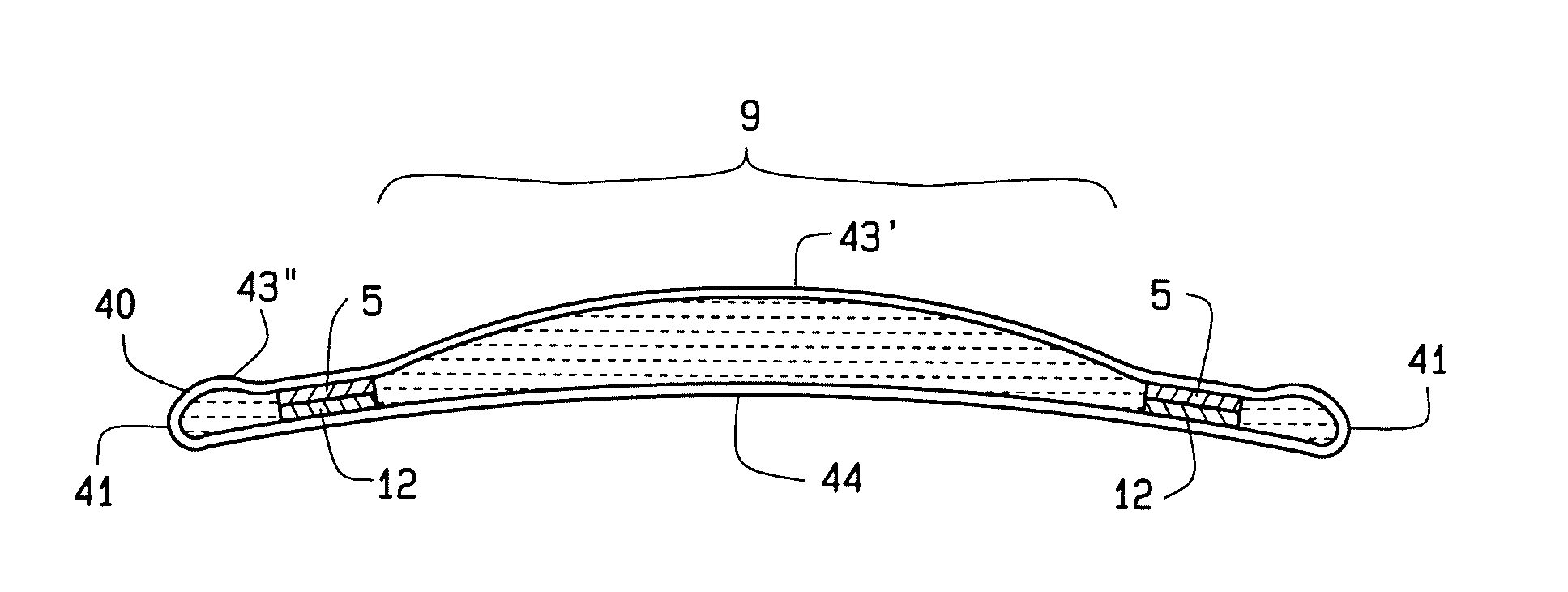Dynamic multifocal contact lens dual layer with core
a multi-layer, contact lens technology, applied in the field of optometry and adjustable focal length lenses, can solve the problems of degrading the view of images, blurry images, and not revealing the use of magnets or fluids within the lens, and achieve the effect of low manufacturing cos
- Summary
- Abstract
- Description
- Claims
- Application Information
AI Technical Summary
Benefits of technology
Problems solved by technology
Method used
Image
Examples
embodiment 2
[0104]FIG. 5 shows a front view of the second embodiment of the invention 1 with its first layer 50 in the foreground. This first layer is of soft contact lens material where soft material adapts to the corneal surface immediately. The first layer is of transparent construction and round shape with a diameter proportional to the iris of a person. The first layer has a round first edge 51 defining its perimeter. Inwardly from the first edge, the lens has the loop antenna 4 that generally follows the first edge though at slightly less diameter and has its two terminals 4a. The terminals connect the antenna 4 to the first electromagnet 5 as described above. The outer edge defines the maximum width of the first electromagnet.
[0105]Generally, this embodiment comprises a contact lens with two annular electromagnets embedded in the layers of the lens as later shown. The electromagnets have a preferred circular form that provides the desired shape when engaged for vision correction of a use...
embodiment 3
[0116]FIG. 9 shows a front view of the third embodiment of the invention 1 with its first layer 60 in the foreground. This first layer is of soft contact lens material that adapts to the corneal surface immediately. The first layer is of transparent construction and round shape with a diameter proportional to the iris of a person. The first layer has a round first edge 61 defining its perimeter. Inwardly from the first edge, the lens has the loop antenna 4 that generally follows the first edge though at slightly less diameter and has its two terminals 4a for connecting to the first electromagnet 5 as described above. The outer edge 6 defines the maximum width of the first electromagnet.
[0117]Generally, this embodiment comprises a contact lens of two layers in a piggyback arrangement with two annular electromagnets, one embedded in each of the two layers of the lens but without a core as later shown. The electromagnets have a preferred circular form that provides the desired shape wh...
embodiment 4
[0125]And the fourth embodiment provides at least two focal lengths, or powers in a single lens. FIG. 13 shows a front view of the invention 1 with its first layer 2 in the foreground. The first layer is of soft lens material that readily adapts to a patient's cornea and has a generally transparent construction and round shape with a diameter proportional to the iris of a person. The first layer has a round first edge 3 defining its perimeter. Inwardly from the first edge, the lens of the invention 1 has a loop antenna 4 that generally follows the first edge though at slightly less diameter. The antenna has two terminals 4a here shown spaced apart though proximate each other. The terminals connect the antenna 4 to the first electromagnet 5 that has a round annular shape with an outer edge 6 slightly less in diameter than the loop antenna. The outer edge defines the maximum width of the first electromagnet.
[0126]This embodiment comprises a contact lens with two annular electromagnets...
PUM
 Login to View More
Login to View More Abstract
Description
Claims
Application Information
 Login to View More
Login to View More - R&D
- Intellectual Property
- Life Sciences
- Materials
- Tech Scout
- Unparalleled Data Quality
- Higher Quality Content
- 60% Fewer Hallucinations
Browse by: Latest US Patents, China's latest patents, Technical Efficacy Thesaurus, Application Domain, Technology Topic, Popular Technical Reports.
© 2025 PatSnap. All rights reserved.Legal|Privacy policy|Modern Slavery Act Transparency Statement|Sitemap|About US| Contact US: help@patsnap.com



